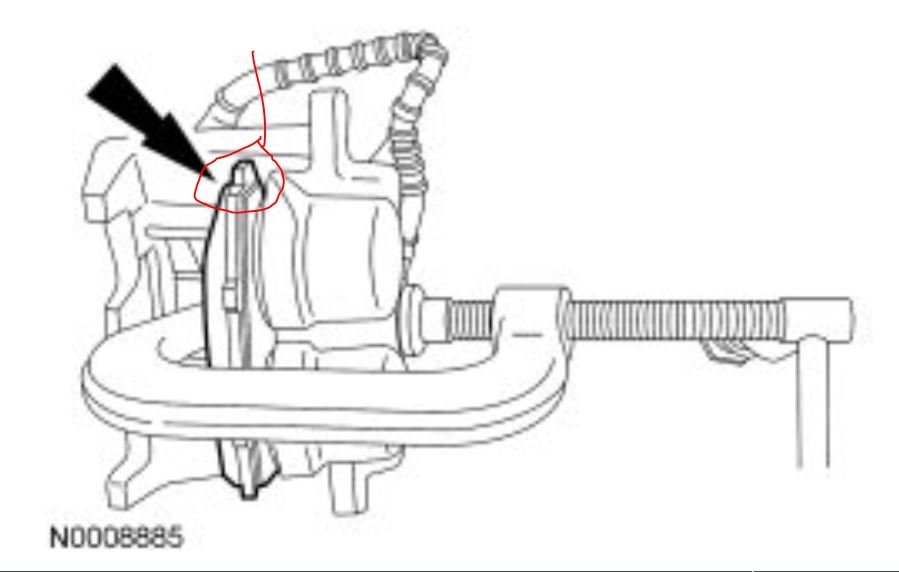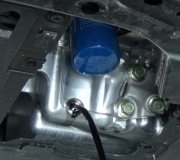Good afternoon,
This sounds like the front pads are making noise. It could either be from they are worn down and the warner tab is rubbing the rotor or the pad material is making the noise.
What kind of pads did you use for the replacement?
https://www.2carpros.com/articles/how-to-replace-front-brake-pads-and-rotors-fwd
Roy
Removal
WARNING: Do not use any fluid other than clean brake fluid meeting manufacturer's specification. Additionally, do not use brake fluid that has been previously drained. Following these instructions will help prevent system contamination, brake component damage and the risk of serious personal injury.
WARNING: Carefully read cautionary information on product label. For emergency medical information seek medical advice. In the USA or Canada on Ford/Motorcraft products call the Poison Control Center. For additional information, consult the product Material Safety Data Sheet (MSDS) if available. Failure to follow these instructions may result in serious personal injury.
WARNING: Always install new brake shoes or pads at both ends of an axle to reduce the possibility of brakes pulling vehicle to one side. Failure to follow this instruction may result in uneven braking and serious personal injury.
NOTICE: Do not spill brake fluid on painted or plastic surfaces or damage to the surface may occur. If brake fluid is spilled onto a painted or plastic surface, immediately wash the surface with water.
NOTICE: Do not allow grease, oil, brake fluid or other contaminants to contact the pad lining material or damage to components may occur. Do not install contaminated pads.
1. Check the brake fluid level in the brake fluid reservoir.
If required, remove fluid until the brake master cylinder reservoir is half full.
2. Remove the wheel and tire. See: Wheels and Tires > Mechanical > Wheels and Tires.
3. NOTICE: Do not use the caliper sight hole to retract pistons as this may damage the pistons and boots.
NOTICE: Do not allow the brake caliper, brake pads and anchor plate assembly to hang from the brake hose or damage to the hose may occur.
Remove and discard the 2 brake caliper guide pin bolts and position the brake caliper aside.
Support the brake caliper using mechanic's wire.
4. NOTE: Install new brake pads if they are worn past the specified thickness above the metal backing plates.
Remove the brake pads and discard the 4 spring clips.
5. Inspect the brake caliper anchor plate assembly.
Check the guide pins and boots for binding or damage.
Lubricate the guide pins with the specified grease.
Install a new brake caliper anchor plate if it is worn or damaged. See: Brake Caliper > Removal and Replacement > Brake Caliper Anchor Plate.
Installation
1. NOTICE: Protect the piston and boots when pushing the caliper piston into the caliper piston bores or damage to the piston or boots may occur.
If installing new brake pads, using a C-clamp and a worn brake pad, compress the brake caliper pistons into the caliper.
imageOpen In New TabZoom/Print
2. NOTE: Install all the hardware supplied with the brake pad kits. For vehicles equipped with an 8 cylinder engine, install the brake pad shims (2 shims for each pad/slotted shim first) and apply a thin coat of the supplied lubricant between the 2 shims.
Install 4 new spring clips and the 2 brake pads.
3. Position the brake caliper on the anchor plate and install 2 new guide pin bolts.
Tighten to 34 Nm (25 lb-ft).
4. If necessary, fill the brake fluid reservoir with clean, specified brake fluid.
5. Apply the brakes several times to verify correct brake operation.
Image (Click to make bigger)
Wednesday, January 13th, 2021 AT 1:05 PM



